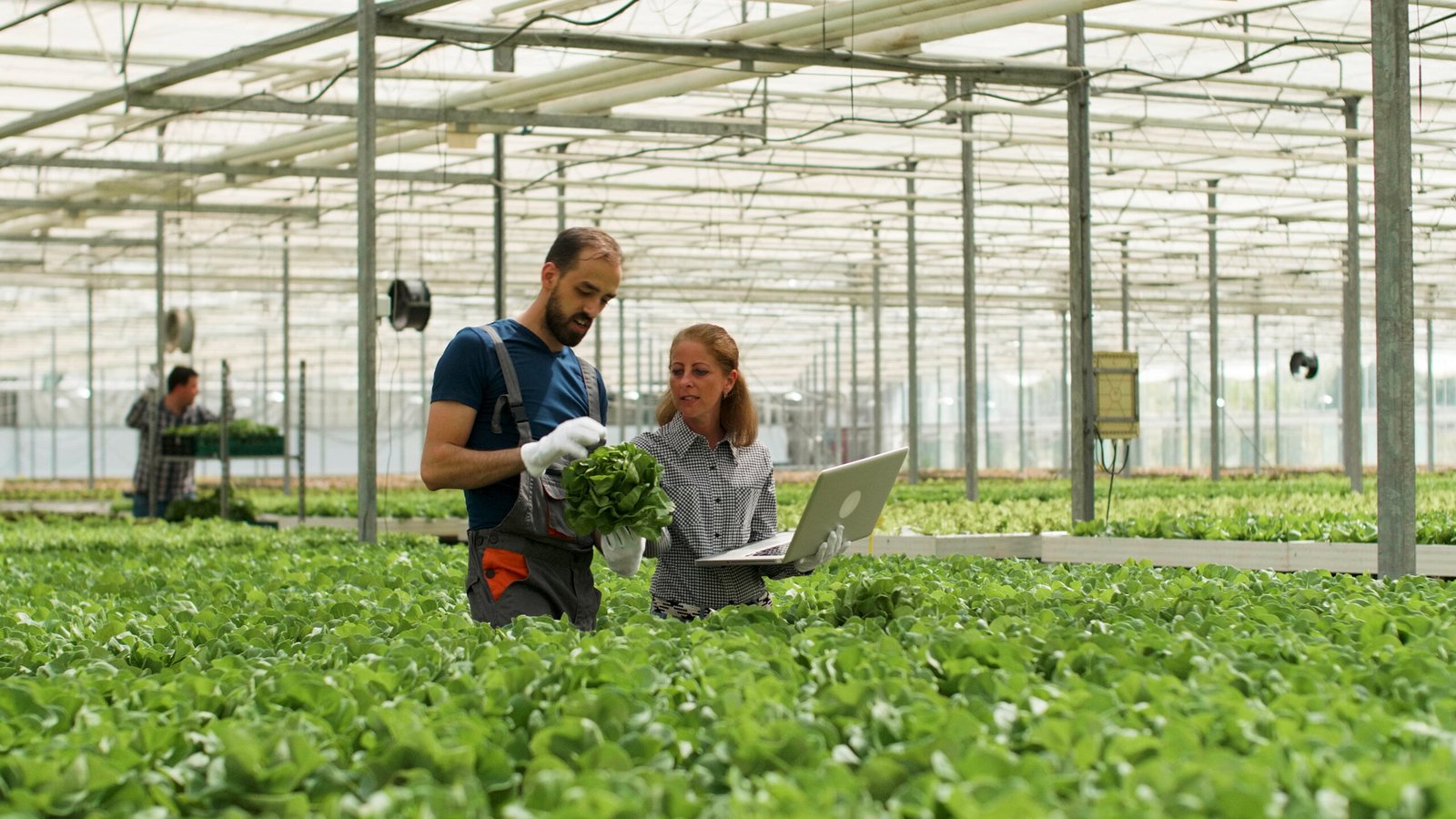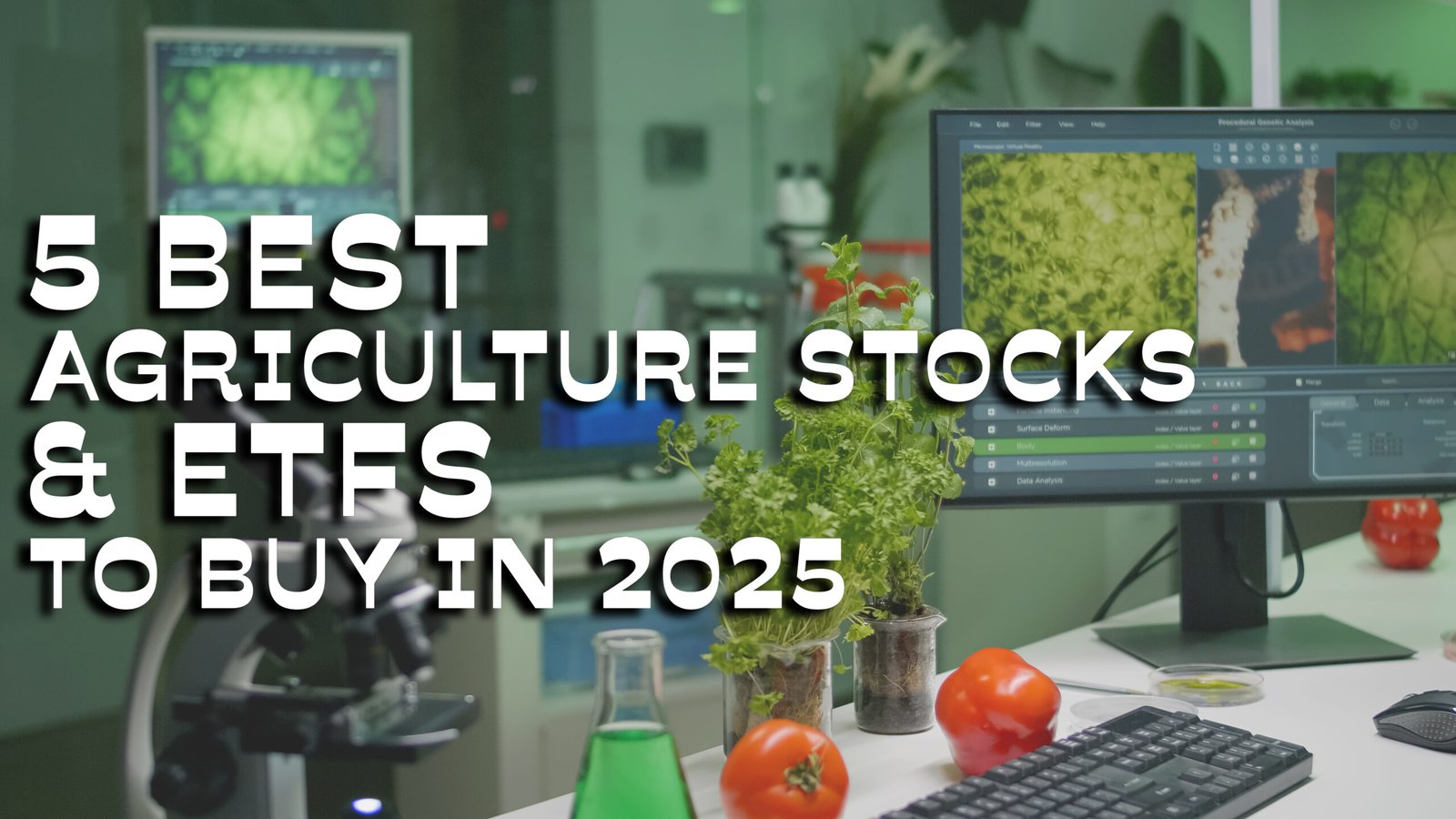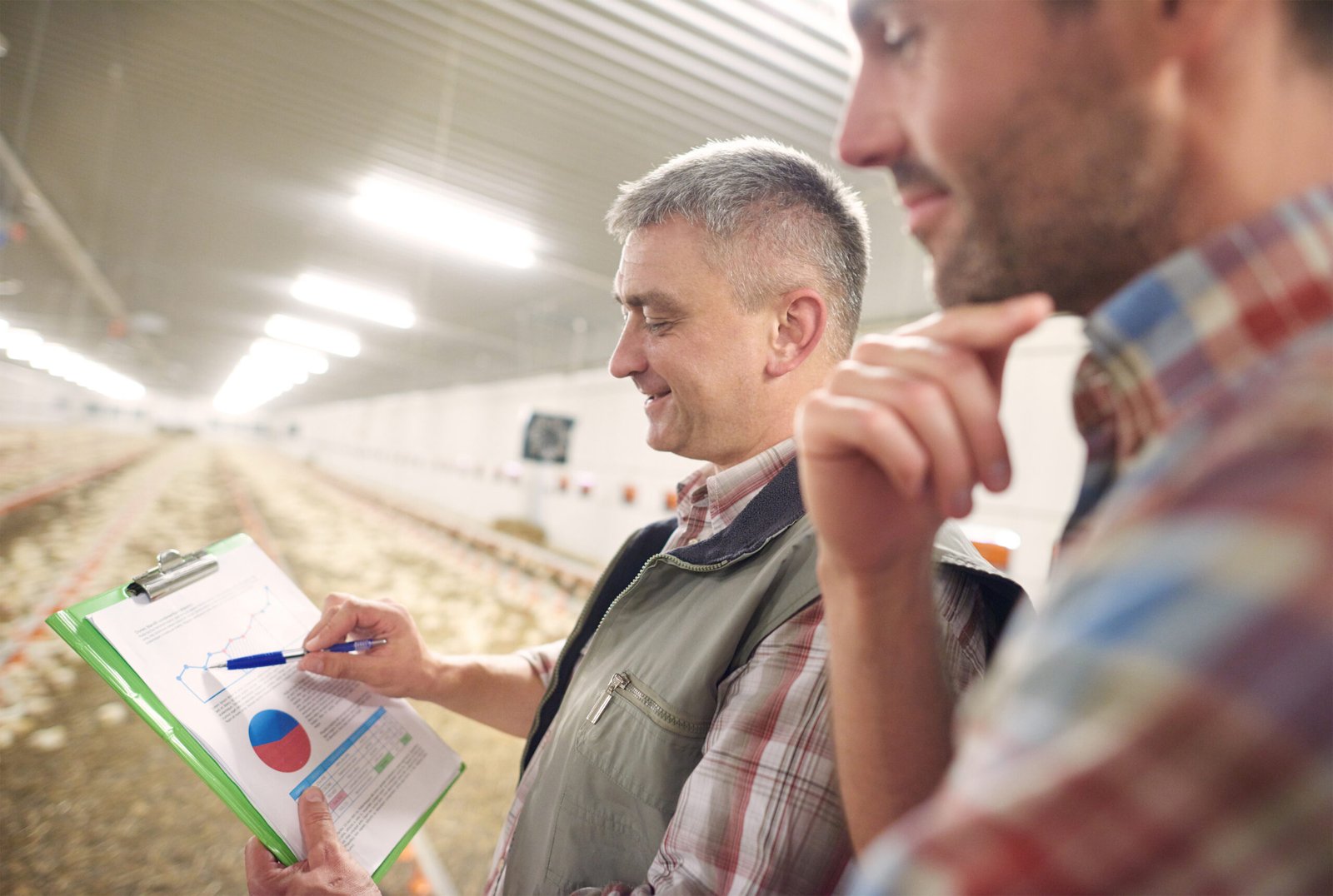Explore the 5 best agriculture stocks and ETFs to buy in 2025. Maximize your returns with sustainable, high-growth picks backed by global food demand trends.

Introduction of Agriculture Stocks And ETFs
The world’s population is expanding and with it, the boundless hunger for food. Demand for food will increase by over 50% in the world by 2050 through population increase, income increase, and changes in diet. Demand is also increased through climate change, soil loss, and resource depletion, jeopardizing the world’s food supply. The agricultural industry, in turn, is reacting by transforming at a very high speed. From intelligent tractors to vertical farming and AI-based crop monitoring, emerging agriculture is being witness to an evolving technology that not only enhances the harvest but offers investable opportunity.
In such a context, farming is today a high-tech, high-speed business from the earlier slow traditional type. While sustainability now dominates global agendas, agriculture companies embracing such revolutions—via the application of precision agriculture, water-efficient technologies, or climate-resilient crops—are also recruiting investors onto their side. Farming no longer tills the soil in 2025—it’s technology, resilience, and sustainability.
In this article, we guide you through why agriculture is a viable investment in 2025, the kind of characteristics to look for in top-performing agriculture stocks and ETFs, and how to make risk estimates. You will also get our top five pick recommendations for an investment—marrying the best of stocks and ETFs—and whether stocks or ETFs are optimal for your investment portfolio.

Why Agriculture Is a Wise Investment in 2025
1. Global Food Security and Population Growth
With ever-larger numbers of mouths to feed every year, agriculture continues to hold the top position for economic and social development. Farming systems will need to adapt fast enough to keep up with the boom with the world population at more than 8.5 billion in 2030. Countries are accelerating investment in farm yields, vertical farming, and drought-tolerant crops in a bid to respond to food needs.
2. Agri-Tech Development and Technological Innovation
Farm field crops are being revolutionized by precision farming, with farm equipment incorporating GPS navigation, artificial intelligence-based data modeling, and remote sensing, making the farmer optimize land use and minimize the wastage of resources. Firms adopting such technology have a greater chance of survival, raising capital, and sustaining growth during recessions.
3. Government Support and Capital for Sustainable Agriculture
Governments everywhere today offer subsidies, tax credits, and R&D grants for green farming. This political windsream is another source of stability and stimulus for sustainable firms—and ever more attractive to socially conscious investors.
4. Hedge Against Inflation
Hedgerow crops like wheat, corn, and soybeans increase in value with inflation, offering natural protection to your portfolio. Other commodities go up and down with currencies depreciating, but demand for staple food is strong, offering a cushion to agriculture.
Agriculture in general is a mix of underlying demand, innovation, subsidy by the government, and inflation protection, and thus, the best sector to invest in 2025.
What to Watch for in Agricultural Stocks And ETFs
1. Mega Commodity or Ag-Tech Exposure
Investing in an agricultural giant such as Archer-Daniels-Midland or an ag-tech precision firm ensures the company is involved in farming or agri-business, enabling high-demand crop exposure. ETFs with exposure focus within an agri-business basket also minimize risk without minimizing growth potential.
2. Pillars of Strong Finance
Look for stable return history, low leverage, and dividend-paying companies. Strength on the books is especially welcome in agriculture because the prices of commodities are extremely volatile. It enables the companies to survive near-term cycle reversals.
3. Diversification Along the Agricultural Chain
The value chain in agriculture includes seed and chemical producers, machinery firms, food processors, and distributors. Select stocks or ETFs that give diversified exposure to various segments of the chain to minimize dependence on success in a single segment.
4. Take Geographic Exposure
Is the ETF or company firmly in U.S. markets, or getting out into emerging markets such as Brazil, India, or Southeast Asia, where demand for agriculture is smoldering? Diversification around the world can open up risk-adjusted returns and give access to more markets.
Diversified, technology-driven, financially strong, and globally oriented are top-performing ag investments

5 Best Agriculture Stocks And ETFs to Buy
In an increasingly unstable world economy, farming is one of the few industries that has strategic value and strong long-run potential. While technology and hip markets will be certain to be in the limelight, farming quietly keeps the countries functioning, feeds the populace, and pays for lines of supply worldwide. Farm stocks and ETFs offer a great place for investors who seek safe, long-term, diversified growth opportunities in as fundamental a market as it is powerful.
As we begin 2025, the agriculture industry is being dynamically transformed by the forces of climate change, food safety, precision ag-tech, and greater pressure to move towards sustainable practices. The shift opens up timely possibilities for investment in exposure to agribusiness, biotech, machinery, and even agri-digital platforms. The charm of investment in agriculture is not only its immunity but also its versatility—being a shareholder in seed genetics companies, to merely monitor farm commodity trade via ETFs.
To invest in the ag market, one has to be a clever one. One has to think about supply chain vulnerabilities, global weather patterns, commodity price action, and international trade policies. One is not attempting to purchase the biggest name but invest in well-placed, good foundation stocks and funds with imprints of macroeconomic themes in the long term. Below are the five best agriculture investments—individual stocks and ETFs—that hold high potential to deliver good performance in 2025 and the foreseeable future.
Regardless of whether you are drawn to passive income, appreciation in capital, or diversification of the portfolio, the agriculture industry holds fertile ground for opportunity. With informed decision-making, you can sow financial seeds today which yield consistent fruits tomorrow.
1. Deere & Company (NYSE: DE)
Deere & Company, more commonly referred to by its brand name, the iconic John Deere, is a global leader in agricultural equipment as well as precision farming technology. As the agricultural industry changed into a technologically advanced and mechanized industry, Deere pioneered such development by implementing AI, GPS-equipped equipment, as well as smart farm devices in its product line. Besides optimally ensuring crop outputs are maximized, these technologies prevent wastage and labor, thus enhancing demand by current farmers.
Deere’s ten-year investment thesis is its technology leadership and consistent top-line support from equipment sales and subscription-based software. Its worldwide diversification of footprint, brand equity, and diversification in construction and forestry products also lead it to the most diversified ag bets. For conservative growth investors who want to get growth out of a legendary name, Deere is still a good bet for 2025.
- Global farm equipment and precision ag-tech leader
- Repeat income–brand name–high
- Riding automation and smart agriculture adoption
- Appreciation value in the long run
- Blue chip income-producing stock
2. Archer-Daniels-Midland Company (NYSE: ADM)
Archer-Daniels-Midland, or ADM, is the portal to the world food chain. ADM is a hub for food ingredient buying, storing, processing, and exporting foods like corn, soybeans, and wheat. As world world-leading agribusiness company, ADM contributes significantly to industrial and food consumption production.
ADM has been investing continuously in plant-based proteins and sustainability, according to the rising global demand for plant-based food and carbon-free operations. Its revenues diversified by food ingredients, biofuels, and animal nutrition make it a recession-proof investment. ADM has room to grow with decent dividends—ideal for long-term investors.
- World-class global food processing and grain handling
- Diversified product portfolio and global distribution network
- Venture in clean vitality and speculation in plant-based proteins.
- Solid cash generation and dividend payout resilience
- Defensive stock during periods of market uncertainty
3. Corteva Agriscience (NYSE: CTVA)
A pure-play agriculture company with a focus on crop protection and seed technology, Corteva is a 2019 spin-off from DowDuPont.
Corteva has emerged as a biotech behemoth in the arena of agriculture within a short period of time. Its innovation model is all about increased yields, climate-resistance crop development, and sustainable agriculture, all of which are now becoming the center point given the scenario of climate change. One of the most powerful reasons why investors adore Corteva is its strong R&D pipeline and global presence.
- It keeps launching next-generation seeds and pest control, giving it technology
- leadership across emerging and developed economies too.
- As a tech-savvy ag leader, it’s one bet that growth-starved investors won’t be able to resist.
- Global presence in 140+ countries
- Riding climate-resilient agriculture trends
4. VanEck Agribusiness ETF (NYSE: MOO)
For investors seeking to diversify in the agricultural space without a single stock selection, a better option is VanEck Agribusiness ETF (MOO). The ETF points to a list of companies locked in agri-products, fertilizers, cultivation apparatus, and nourishments. Large holdings are registered in the names of Deere & Co., Corteva, and Nutrien, among others.
MOO derives benefits from direct access to the broader agribusiness world and can be used as a focus holding vehicle for investors requiring access to the global food system. It is facilitated by demand for food globally, ag-tech technology solutions, and supply chain enhancements. The ETF is very liquid and supported by a highly respected fund manager, and as such it is accessible to novice and sophisticated investors.
- Broadly diversified exposure to top-performing global agribusiness equities
- Diversifies single-stock risk with portfolio holdings in diversified equities
- Liquid and easily sellable in the majority of brokerage accounts
- Scans of ag-tech titans, fertilizers, and equipment
- Ideal for long-term passive appreciation
5. Invesco DB Agriculture Fund (NYSE: DBA)
Another appropriate choice for exposure to agriculture—but with commodity taste, not equities—is the Invesco DB Agriculture Fund (DBA). It invests in futures contracts on agricultural commodities of corn, wheat, coffee, and sugar. It’s designed to track the price of the DBIQ Diversified Agriculture Index.
DBA is appropriate to hedge rising inflation or capitalize on rising food prices, which correlate with rising whenever the supply environment is bumpy or the global economy shifts. More volatile than equity-based ETFs, its commodity index component offers a diversification benefit. Investors who need to wager on short- to intermediate-term farm trends have the upper hand with DBA.
- Commodity-linked ETF based on agricultural futures
- Better protection against world supply shocks and inflation inertia
- Exposure to well-placed crops like wheat and corn
- Increased risk with greater short-run payback
- Suits the tactical asset allocation of multi-dimensional portfolios
Major Risks to Note Before Investing in Agriculture Stocks And ETFs
1. Volatility of commodity prices
Prices of commodities like soybeans, corn, or wheat tend to get out of hand with cyclical patterns by seasons, worldwide demand, or currency shifts. Businesses that are dependent on a single commodity are worst hit by astronomical losses in a crisis.
2. Climate Change and Natural Disasters
Drought, floods, and erratic climatic patterns threaten livestock as much as crops. Successful businesses are also exposed to derailment if their activities are greatly compromised by an act of nature.
3. Formulating Trade and Regulation Policies
World agriculture responds to tariffs, trade treaties, and agricultural subsidies. Political unrest or regulation results in supply chains getting disrupted, exports being affected, and profitability being provoked.
4. Supply Chain Bottlenecks
Transport and labor concerns, especially in post-pandemic settings, might take their time in transporting and seep into harvest calendars. Businesses with poor logistics cores might fail to meet demand or remain profitable.
Short, promise do agri—Plain risk, nonetheless. The reward must be balanced against prudent risk control.
Are ETFs Better than Individual Stocks for Beginners?
1. Convenience and In-Built Diversification
ETFs are also a good option for the beginner investor because they allow you to invest in a bunch of companies without having to be a “winner picker.” An ETF like VanEck Agribusiness ETF (MOO) will expose you to seed companies, farm machinery, and agri-chemicals all at once.
2. Risk Reduction
Investing in several agri-industry stocks limits your risk since the low performance of one of the firms will be offset. This makes the ETF safer as well as more affordable for new investors.
3. When Stocks Can Be a Better Bet
If you have greater risk tolerance, time to research, and enthusiasm to benefit from the growth trajectory of a company—such as Deere’s growth in smart tractors—then stocks can be more profitable on an individual basis.
4. Balanced Strategy
Both options are taken by most investors: holding ETFs for uniformity and stocks for defensive gains. To illustrate, you may hold MOO as the underlying exposure and Corteva Agriscience because it contains an underlying theme of seed innovation.
For most new investors, ETFs offer a diversified, risk-free entry point, but for all the performance addicts out there, the blend of some agriculture stocks will be enjoyed.
Are Agriculture Stocks And ETFs Right for Your Portfolio?
Agriculture is less about seeding food and more about seeding value. In 2025, in times of uncertainty, climate disruptions, and increasing demand, agriculture is a silver bullet sector to generate wealth over the long term. It meets all the criteria of high demand, innovation, ESG suitability, and inflation protection.
If you are a growth investor who wants to get some exposure in megatrends, agriculture gives scaleability. If you’re an income investor, several agribusiness companies offer stable dividends. And if you’re an ESG investor, sustainable agri and green agri-tech options offer moral alignment.
Investment in ag is an investment for the long-term vision and strategy. If you understand the risks, choose the right stocks and ETFs, and choose firms that are trendsetters of sustainable agriculture, you are bound to receive monetary as well as global dividends.
Advantages and Disadvantages of Investing in Agriculture Stocks and ETFs
Advantages:
- Key Industry: Farming will always remain in style because it is feeding the planet.
- Inflation Hedge: Food and commodity prices increase with inflation.
- Diversified Investment Opportunities: Invest in commodity following, processing, machinery, or biotech industries.
- Long-Term Growth: Population and food security create demand.
- Sustainability Alignment: Agriculture dominates ESG themes.
Disadvantages:
- Weather and Climate Risks: Flooding, pests, or drought could swamp profits.
- Volatility in Commodity Prices: Crop and input prices are massively cyclical in nature.
- Regulatory Risk: Farming companies are policy-regulated by the government.
- Global Exposure Risks: Global businesses are exposed to exchange and geopolitical risks.
- Slow Innovation in Certain Sectors: Agriculture is not a thing as technology, which is done instantly. Agriculture may take time to provide instant returns.
FAQs of Agriculture Stocks and ETFs
Q1: Is agriculture ETF superior to individual stocks?
Agriculture ETF provides diversification and lower risk, and individual stocks can provide more if properly researched.
Q2: How much of my portfolio is to invest in agri?
A 5-15% could be a sensible thumb to run the show, depending on chance resistance and venture skyline.
Q3: Can agri stocks be used as an inflation hedge?
Yes, all agri investments, but especially commodity ETFs like DBA, make good hedges against inflation.
Q4: What should start-ups avoid in Agri stocks?
Avoid financial health, dividend consistency, market leadership, and ESG consistency among agri-stocks.
Q5. Are they long-term growth-friendly?
Yes, in fact, agriculture has sustained growth potential driven by global demand and technology.
Conclusion:
Agricultural investing is not so much planting and breeding cattle as it is forward-thinking for your portfolio. Regardless of whether dividends, growth, or inflation cover is on your to-do list, agriculture stocks and ETFs present multiple points of entry for investors. From market giants Deere and ADM to multi-basket plays in MOO and DBA, these investments can be rolled into a variety of investor plans.
Agriculture lags behind crypto or tech but continues to be steady, low-grade growth. Especially in 2025 when the world’s needs for food are growing and sustainability is a grand problem, investors stand to heavily benefit from the agricultural revolution.
References:
- Deere & Company – Investor Relations
- Archer-Daniels-Midland (ADM) Company Profile – Yahoo Finance
- Corteva Agriscience – Corporate Overview
- VanEck Agribusiness ETF (MOO)
- Invesco DB Agriculture Fund (DBA)










